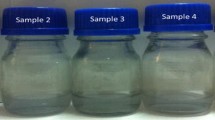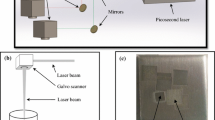Abstract
The objective of this study is to investigate the effects of liquid environment on the properties of TiO2 nanoparticles. TiO2 nanoparticles were synthesized by pulsed laser ablation method in distilled water, acetone, and CTAB. To investigate the structural properties of samples X-ray diffraction pattern, transmission electron microscopy, and scanning electron microscopy were employed. UV–Vis–NIR absorption spectroscopy, FTIR and photoluminescence of TiO2 nanoparticles were used to study their optical properties. Results show that ablation liquid environment has strong effect on size and adhesion of nanoparticles. It is found that ablation of Ti target in distilled water medium leads to formation of smaller size nanoparticles with narrower size distributions in comparison with two other liquid environments. Adhesion of nanoparticles produced in the CTAB and acetone environment are smaller than adhesion of nanoparticles produced in the distilled water environment. Direct bandgap energy of nanoparticles was found to be 3.85, 3.72 and 3.18 eV for sample produced in water, CTAB, and acetone medium respectively. TiO2 nanoparticles were found almost spherical in shape and polycrystalline in all liquids.









Similar content being viewed by others
References
N. E. Jasbi and D. Dorranian (2017). Dependence of laser ablation produced TiO2 nanoparticles on the ablation environment temperature. Opt. Quantum Electron.49, 209.
E. Giorgetti, M. M. Miranda, S. Caporali, P. Canton, P. Marsili, C. Vergari, and F. Giammanco (2015). TiO2 nanoparticles obtained by laser ablation in water: influence of pulse energy and duration on the crystalline phase. J. Alloys Compd.643, S75–S79.
L. Li, J. Yan, T. Wang, Z. J. Zhao, J. Zhang, J. Gong, and N. Guan (2015). Sub-10 nm rutile titanium dioxide nanoparticles for efficient visible-light-driven photocatalytic hydrogen production. Nat. Commun.6, 5881.
G. G. Guillén, S. Shaji, M. M. Palma, D. Avellaneda, G. A. Castillo, T. D. Roy, D. G. Gutiérrez, and B. Krishnan (2017). Effects of ablation energy and post-irradiation on the structure and properties of titanium dioxide nanomaterials. Appl. Surf. Sci.405, 183–194.
X. Chen, D. Zhao, K. Liu, C. Wang, L. Liu, B. Li, Z. Zhang, and D. Shen (2015). Laser-modified black titanium oxide nanospheres and their photocatalytic activities under visible light. ACS Appl. Mater. Interfaces7, 16070–16077.
X. Chen and S. S. Mao (2007). Titanium dioxide nanomaterials: synthesis, properties, modifications, and applications. Chem. Rev.107, 2891–2959.
V. A. Zuñiga-Ibarra, S. Shaji, B. Krishnan, J. Johny, S. S. Kanakkillam, D. A. Avellaneda, J. A. Martinez, T. D. Roy, and N. A. Ramos-Delgado (2019). Synthesis and characterization of black TiO2 nanoparticles by pulsed laser irradiation in liquid. Appl. Surf. Sci.483, 156–164.
E. Solati, L. Dejam, and D. Dorranian (2014). Effect of laser pulse energy and wavelength on the structure, morphology and optical properties of ZnO nanoparticles. Opt. Laser Technol.58, 26–32.
D. Dorranian, E. Solati, and L. Dejam (2012). Photoluminescence of ZnO nanoparticles generated by laser ablation in deionized water. Appl. Phys. A109, 307–314.
E. Solati and D. Dorranian (2016). Nonlinear optical properties of the mixture of ZnO nanoparticles and graphene nanosheets. Appl. Phys. B122, 76.
E. Solati and D. Dorranian (2015). Comparison between silver and gold nanoparticles prepared by pulsed laser ablation in distilled water. J. Clust. Sci.26, 727–742.
A. Mehrani, D. Dorranian, and E. Solati (2015). Properties of Au/ZnO nanocomposite prepared by laser irradiation of the mixture of individual colloids. J. Clust. Sci.26, 1743–1754.
P. Azadfar, E. Solati, and D. Dorranian (2018). Properties of Au/Copper oxide nanocomposite prepared by green laser irradiation of the mixture of individual suspensions. Opt. Mater.78, 388–395.
M. Savadkoohi, D. Dorranian, and E. Solati (2018). Using silicon nanoparticles to modify the surface of graphene nanosheets. Mater. Sci. Semiconduct. Process.75, 75–83.
E. Solati, M. Savadkoohi, and D. Dorranian (2018). Nonlinear optical response of graphene/silicon nanocomposites. Opt. Quantum Electron.50, 268.
E. Solati, M. Mashayekh, and D. Dorranian (2013). Effects of laser pulse wavelength and laser fluence on the characteristics of silver nanoparticle generated by laser ablation. Appl. Phys. A112, 689–694.
M. Moradi, E. Solati, S. Darvishi, and D. Dorranian (2016). Effect of aqueous ablation environment on the characteristics of ZnO nanoparticles produced by laser ablation. J. Clust. Sci.27, 127–138.
A. Zamiranvari, E. Solati, and D. Dorranian (2017). Effect of CTAB concentration on the properties of graphene nanosheet produced by laser ablation. Opt. Laser Technol.97, 209–218.
E. Solati and D. Dorranian (2016). Effect of temperature on the characteristics of ZnO nanoparticles produced by laser ablation in water. Bull. Mater. Sci.39, 1677–1684.
E. Solati and D. Dorranian (2017). Estimation of lattice strain in ZnO nanoparticles produced by laser ablation at different temperatures. J. Appl. Spectrosc.84, 490–497.
E. Solati, E. Vaghri, and D. Dorranian (2018). Effects of wavelength and fluence on the graphene nanosheets produced by pulsed laser ablation. Appl. Phys. A124, 749.
S. Kamali, E. Solati, and D. Dorranian (2019). Effect of laser fluence on the characteristics of graphene nanosheets produced by pulsed laser ablation in water. J. Appl. Spectrosc.86, 238–243.
A. Chaturvedi, M. P. Joshi, P. Mondal, A. K. Sinha, and A. K. Srivastava (2017). Growth of anatase and rutile phase TiO2 nanoparticles using pulsed laser ablation in liquid: influence of surfactant addition and ablation time variation. Appl. Surf. Sci.396, 303–309.
H. Sadeghi, E. Solati, and D. Dorranian (2019). Producing graphene nanosheets by pulsed laser ablation: effects of liquid environment. J. Laser Appl.31, 042003.
C. H. Liang, Y. Shimizu, T. Sasaki, and N. Koshizaki (2005). Preparation of ultrafine TiO2 nanocrystals via pulsed-laser ablation of titanium metal in surfactant solution. Appl. Phys. A80, 819–822.
M. Zimbone, M. A. Buccheri, G. Cacciato, R. Sanz, G. Rappazzo, S. Boninelli, R. Reitano, L. Romano, V. Privitera, and M. G. Grimaldi (2015). Photocatalytical and antibacterial activity of TiO2 nanoparticles obtained by laser ablation in water. Appl. Catal. B Environ.165, 487–494.
F. Barreca, N. Acacia, E. Barletta, D. Spadaro, G. Currò, and F. Neri (2010). Small size TiO2 nanoparticles prepared by laser ablation in water. Appl. Surf. Sci.256, 6408–6412.
N. E. Jasbi and D. Dorranian (2016). Effect of aging on the properties of TiO2 nanoparticle. J. Theor. Appl. Phys.10, 157–161.
P. Jafarkhani, S. Dadras, M. J. Torkamany, and J. Sabbaghzadeh (2010). Synthesis of nanocrystalline titania in pure water by pulsed Nd: YAG Laser. Appl. Surf. Sci.256, 3817–3821.
A. S. Nikolov, P. A. Atanasov, D. R. Milev, T. R. Stoyanchov, A. D. Deleva, and Z. Y. Peshev (2009). Synthesis and characterization of TiOx nanoparticles prepared by pulsed-laser ablation of Ti target in water. Appl. Surf. Sci.255, 5351–5354.
V. Amendola and M. Meneghetti (2013). What controls the composition and the structure of nanomaterials generated by laser ablation in liquid solution? Phys. Chem. Chem. Phys.15, 3027–3046.
A. Kanitz, J. S. Hoppius, M. del Mar Sanz, M. Maicas, A. Ostendorf, and E. L. Gurevich (2017). Synthesis of magnetic nanoparticles by ultrashort pulsed laser ablation of iron in different liquids. ChemPhysChem18, 1155–1164.
J. Tauc and A. Menth (1972). States in the gap. J. Noncryst. solids8, 569–585.
R. M. Tilaki, A. Iraji zad, and S. M. Mahdavi (2006). Stability, size and optical properties of silver nanoparticles prepared by laser ablation in different carrier media. Appl. Phys. A84, 215–219.
M. H. Mahdieh and B. Fattahi (2015). Size properties of colloidal nanoparticles produced by nanosecond pulsed laser ablation and studying the effects of liquid medium and laser fluence. Appl. Surf. Sci.329, 47–57.
J. M. Notestein, E. Iglesia, and A. Katz (2007). Photoluminescence and charge-transfer complexes of calixarenes grafted on TiO2 nanoparticles. Chem. Mater.19, 4998–5005.
N. D. Abazović, M. I. Čomor, M. D. Dramićanin, D. J. Jovanović, S. P. Ahrenkiel, and J. M. Nedeljković (2006). Photoluminescence of anatase and rutile TiO2 particles. J. Phys. Chem. B110, 25366–25370.
J. Liqiang, S. Xiaojun, C. Weimin, X. Zili, D. Yaoguo, and F. Honggang (2003). The preparation and characterization of nanoparticle TiO2/Ti films and their photocatalytic activity. J. Phys. Chem. Solids64, 615–623.
B. Santara, P. K. Giri, K. Imakita, and M. Fujii (2013). Evidence for Ti interstitial induced extended visible absorption and near infrared photoluminescence from undoped TiO2 nanoribbons: an in situ photoluminescence study. J. Phys. Chem. C117, 23402–23411.
Author information
Authors and Affiliations
Corresponding author
Additional information
Publisher's Note
Springer Nature remains neutral with regard to jurisdictional claims in published maps and institutional affiliations.
Rights and permissions
About this article
Cite this article
Solati, E., Aghazadeh, Z. & Dorranian, D. Effects of Liquid Ablation Environment on the Characteristics of TiO2 Nanoparticles. J Clust Sci 31, 961–969 (2020). https://doi.org/10.1007/s10876-019-01701-w
Received:
Published:
Issue Date:
DOI: https://doi.org/10.1007/s10876-019-01701-w




